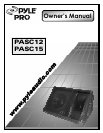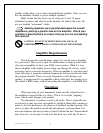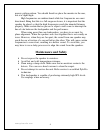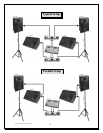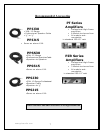
3
parallel, which allows you to daisy chain additional speakers. Thus you can
use one amplifier channel to power multiple speakers.
Make certain that the wires you are using are at least 12 gauge
unshielded speaker cable (the lower the number, the thicker the wire). Do
not use shielded “instrument” cables.
Hooking speakers up in parallel decreases the overall
impedance, placing a greater load on the amplifier. Check your
amplifier’s specifications to ensure that you are not overloading
the channel.
CAUTION: DO NOT USE MORE THAN ONE JACK AS AN
AMPLIFIER INPUT. DOING SO WILL DAMAGE THE SPEAKER!
Amplifier Requirements
Check the product specifications (page 5) to see the power handling
for your model. There are a couple of considerations to keep in mind when
choosing an amplifier to drive your PASC series speaker. While it is true
that an amplifier with a higher power rating can damage the drivers, under-
powering can be even more dangerous. When an amplifier is overdriven and
starts distorting, it generates transient frequencies that are much louder than
the program material. These wayward frequencies could damage your
speaker. A proper match is an amplifier which could drive the speaker up to
the cabinet’s RMS rating, without exceeding the amplifier’s own RMS level.
Operation
When powering on your equipment, make sure the volume level on
the amplifier is turned all the way down. This is to avoid the “popping”
noise, which could damage your speaker.
The placement of speakers can be a bit tricky. This is especially true
to monitors as they are more susceptible to feedback. Being that a monitor is
meant to face the performers, the chances of feedback are much greater. The
trick is to place the monitor outside the microphone’s pickup pattern. For
most microphones the best position is directly behind the mic. Supercardioid
mics however, do not reject sound from the back very well, but do have a



